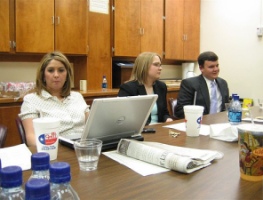 One of the joys of being around entrepreneurs and academicians is that you get pulled in to interview folks – in person, on the phone or Skype, and sometimes as part of a panel. This last weekend, I was part of one such interview panel – where nearly six senior candidates who’d been shortlisted were interviewed. Three things struck me about the experience
One of the joys of being around entrepreneurs and academicians is that you get pulled in to interview folks – in person, on the phone or Skype, and sometimes as part of a panel. This last weekend, I was part of one such interview panel – where nearly six senior candidates who’d been shortlisted were interviewed. Three things struck me about the experience
- How vastly different approaches the various candidates brought to the interview process
- Even the senior candidates made some of the same rookie mistakes that you expect only younger ones to make
- How we, as the interview panel, could have done things better (that’s a whole another post)
Ask questions – In this particular panel, the thing that stood out the most for me, was how few questions the interviewees had for us as a panel. Sure they’d spoken to the hiring manager over the phone prior to the interview, but given the panel had veto power (did they know that?) it would have been better for them to ask more questions. While this is true even for 1:1 interviews, with a panel it’s important to understand what different people in the panel expect both of the role that you’re interviewing for and of the interview process itself. This will make sure you are neither blind-sided nor leave something unaddressed. Even more importantly your questions often will say a lot more about your than your answers.
Be specific A panel, with the very fact there are more than three people (ours had five), can easily get bogged down when it comes to decision-making. So it’s very important for you to be very specific with both your answers to their questions and even with your own questions. This allows you to stand out as a candidate. This requires you to avoid generalities – such as “I have strong networks in the community” and you’d be better of with specifics such as “I was able to recruit six mentors from the community in my first three months on the job. And these folks served with us on average for two years.” Balance the desire to be specific with the need to be concise – not always easy, but with practice can be done.
Be concise If you are like me (poor you!) the temptation is great to jump right in, when a question is posed. All too often, I get excited about the topic – which is usually why I’m there – and begin talking or responding. Two tips to being concise – clarify what is being sought and validate whether you’ve answered their question. We make assumptions that may just not be correct – it is better to clarify before attempting to answer. In our specific job search, we wanted the candidate to make his organization, financially independent at some point. One candidate anxious that this was important to us focused on becoming self-sufficient within two years – which meant she recommended doing a lot of things, not central to the business, just to generate revenues. Clarifying the timeline over which the panel expected the organization to be self-sufficient could have easily avoided this.
Demonstrate Interest Many interview candidates assume that they are demonstrating interest by showing up. Why else would they be there? However, while showing up is necessary it is definitely not enough to show your interest in the job. The most attractive candidate – going by their resume and phone screen – turned out to be lowest ranked in our panel, due to the utter lack of energy and interest demonstrated by his body language and cadence during the panel interview. Most organizations are looking to hire people with energy and a good deal of motivation to make things happen. Sure they want to know and prefer you’ve done it before but are you willing and ready to do it and more, again? So it’s important to demonstrate interest – which of course asking questions, clarifying and engaging will all help you.
Not surprisingly most of these tips are useful for 1:1 interviews. However, it’s both easier to develop rapport in 1:1 interviews as well as recover from mistakes, with a little honesty and self-deprecation. Even the best of candidates can be undone with a panel, if there’s either non-alignment on the other side of the table or you don’t address the primary careabouts for the key decision makers on a panel. Share your own experiences interviewing with panels and what’s worked for you. Good luck!










You must be logged in to post a comment.